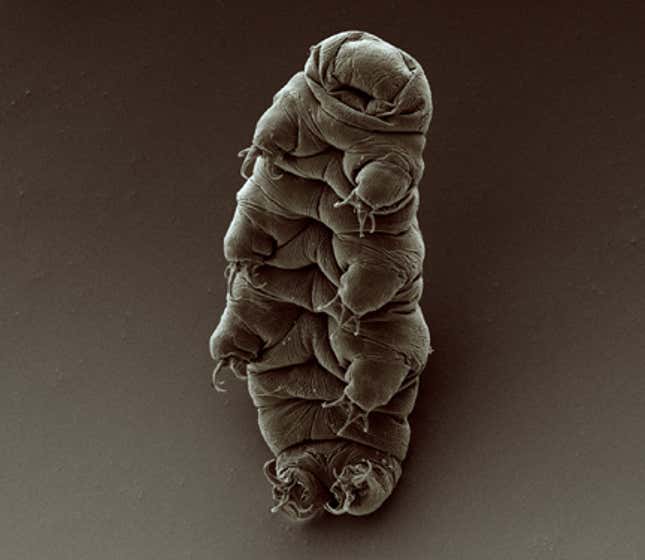
Tardigrades. Water bears. Moss piglets. No matter their name, the microscopic invertebrates are notoriously tough, and now, a team of researchers studied the tardigrade’s ancestors to figure out how the animal evolved.
The research team studied lobopodians, a group of extinct soft-bodied worms from the Cambrian Period, and modern tardigrades to determine which features of the latter group were inherited from the former. The team’s findings were published this week in the Proceedings of the National Academy of Sciences.
“Prior to our work, our understanding of tardigrade evolution was limited,” said Ji-Hoon Kihm, a paleobiologist at the Korea Polar Research Institute and the study’s lead author, in an email to Gizmodo. “We revealed the ancestral and derived morphological traits in tardigrades, and we established a close relationship between tardigrades and luolishaniid lobopodians.”
The luolishaniid lobopodians were a group of Cambrian critters with five or six pairs of bristly appendages on their rear end. Modern tardigrades have four pairs of claws for limbs, rather than digits.

“Two key differences between tardigrades and luolishaniids are the relative length of legs and the number of trunk segments: tardigrades have relatively shorter legs and the smaller number of trunk segments compared to luolishaniids, likely resulting from the loss of developmental genes,” Kihm added.
Though creatures like the lobopodian ancestors of tardigrades had soft bodies, their remains are immaculately preserved thanks to their seafloor habitats. The Cambrian Period included a 53-million-year stretch over half a billion years ago (the “Cambrian Explosion”) that saw an incredible burst of biological diversity on Earth, most of it at the seafloor. Filter-feeders ran amok.
Stunning fossils of these creatures are found in places like China’s Qingjiang Biota and Canada’s Burgess Shale, now a mountain range, which was at the bottom of the sea 500 million years ago.
“The hypothesis that the luolishaniid lobopodians are stem group tardigrades is new and worth serious consideration,” said Joe Moysiuk, a paleobiologist at the Royal Ontario Museum in Toronto who was unaffiliated with the new paper, in an email to Gizmodo. “The speculations about developmental processes that might have contributed to the origin of the tardigrade body plan are also fascinating and insightful.”
Moysiuk has reported several new species from the Burgess Shale, including the zeppelin-shaped Titanokorys gainesi and Cambroraster falcatus, named for Han Solo’s Millennium Falcon. He noted that some of the features linked between luolishaniids and tardigrades by the researchers also appear in other lobopodian critters, like Hallucigenia, a positively mind-boggling animal from the Cambrian.

“Given the interpretive challenges when working with half billion-year-old fossils, I doubt this will be the last word on luolishaniid relationships,” Moysiuk added.
Tardigrades walk like creatures 500,000 times their size, perhaps a relic of their macroscopic ancestors. At some point in the evolutionary timeline, the animals began to shrink down, giving way to the roughly 1 mm (.04-inch) creature.
Kihm noted that previous studies reported the loss of developmental genes associated with the midriff and legs of tardigrades. “In our study, we corroborate the findings suggested by these studies, using Cambrian fossils,” he said. “The loss of these genes might be linked to the miniaturization process observed in tardigrades.”
There are plenty of secrets that tardigrades still hold close to their microscopic chests. The invertebrates are famously resilient—they’re extremophiles, meaning they love conditions that are inhospitable for most other organisms. When tardigrades encounter environmental stress, they undergo cryptobiosis, a process which allows them to suspend all metabolic activity.
Tardigrades’ hardiness also makes them fodder for scientists’ most quixotic experiments. Tardigrades were blasted with ultraviolet radiation in 2020, and shot from guns in 2021 to test a theory about aliens. Last year, a team of physicists claimed they made a tardigrade part of a quantum system.
Some tardigrade fossils have turned up—including one 16-million-year-old tardigrade encased in amber—but it will take a multidisciplinary combination of paleozoology, genetic analysis, and more to understand exactly how this unique animal came to be.